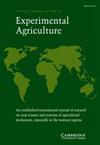基于GreenSeeker近端光学传感器的小麦氮肥优化算法研究
IF 1.9
4区 农林科学
Q1 Agricultural and Biological Sciences
引用次数: 13
摘要
摘要采用主动冠层传感器的近端植物传感在作物农艺信息的无损评估方面提供了一个飞跃。为了管理肥料氮(N),必须使用函数模型或算法将传感器读数转换为肥料量。在埃及西尼罗河三角洲的三个小麦季节进行了六次田间试验,以开发和验证一种基于GreenSeeker冠层反射率传感器的小麦田间特定肥料氮管理算法,该算法考虑了作物生长季节氮的空间和时间变异性。所提出的算法基于对总氮吸收的预测和氮吸收的响应指数,该指数由传感器从产量潜力不同的地块测量的归一化差异植被指数确定,该地块是通过在前两个小麦季节进行的四个实验中施用一系列肥料氮水平而建立的。在第三个小麦季节进行的两个实验中的处理旨在确定在Feekes 6期(拔节期)施用基于传感器的剂量之前的适当肥料氮管理。在小麦播种后10天和30天施用40公斤和60公斤N ha−1,并使用本研究中开发的算法估计传感器引导的N剂量,结果与遵循一般建议获得的产量相似,但肥料N平均减少66公斤N ha–1。与一般建议相比,这些结果还反映在氮回收率(21.9%)和农艺(7.7 kg粮食kg−1 N)效率的显著提高上,从而证明了基于传感器的算法在优化小麦肥料氮管理方面的有用性。本文章由计算机程序翻译,如有差异,请以英文原文为准。
Development of an algorithm for optimizing nitrogen fertilization in wheat using GreenSeeker proximal optical sensor
Abstract Proximal plant sensing with active canopy sensors offers a leap in the non-destructive assessment of crop agronomic information. For managing fertilizer nitrogen (N), sensor readings must be translated using functional models or algorithms to fertilizer amounts. Six field experiments were conducted in three wheat seasons in the West Nile Delta in Egypt to develop and validate an algorithm based on GreenSeeker canopy reflectance sensor for field-specific fertilizer N management in wheat, which takes into account both spatial and temporal variability of N during the crop growth season. The proposed algorithm is based on the prediction of total N uptake and response index of N uptake determined from normalized difference vegetation index measured by the sensor from plots differing in yield potential as established by applying a range of fertilizer N levels in the four experiments conducted in the first two wheat seasons. The treatments in the two experiments conducted in the third wheat season were designed to define appropriate fertilizer N management prior to applying a sensor-based dose at Feekes 6 stage (jointing stage). The application of 40 and 60 kg N ha−1 at 10 and 30 days after sowing of wheat and a sensor-guided dose of N estimated by using the algorithm developed in this study resulted in yields similar to those obtained by following the general recommendation, but with an average of 66 kg N ha−1 less fertilizer N. These results were also reflected in a substantial increase in N recovery (21.9%) and agronomic (7.7 kg grain kg−1 N) efficiencies compared with the general recommendation, thereby proving the usefulness of the sensor-based algorithm in optimizing fertilizer N management in wheat.
求助全文
通过发布文献求助,成功后即可免费获取论文全文。
去求助
来源期刊

Experimental Agriculture
农林科学-农艺学
CiteScore
2.50
自引率
6.20%
发文量
29
审稿时长
24 months
期刊介绍:
With a focus on the tropical and sub-tropical regions of the world, Experimental Agriculture publishes the results of original research on field, plantation and herbage crops grown for food or feed, or for industrial purposes, and on farming systems, including livestock and people. It reports experimental work designed to explain how crops respond to the environment in biological and physical terms, and on the social and economic issues that may influence the uptake of the results of research by policy makers and farmers, including the role of institutions and partnerships in delivering impact. The journal also publishes accounts and critical discussions of new quantitative and qualitative methods in agricultural and ecosystems research, and of contemporary issues arising in countries where agricultural production needs to develop rapidly. There is a regular book review section and occasional, often invited, reviews of research.
 求助内容:
求助内容: 应助结果提醒方式:
应助结果提醒方式:


